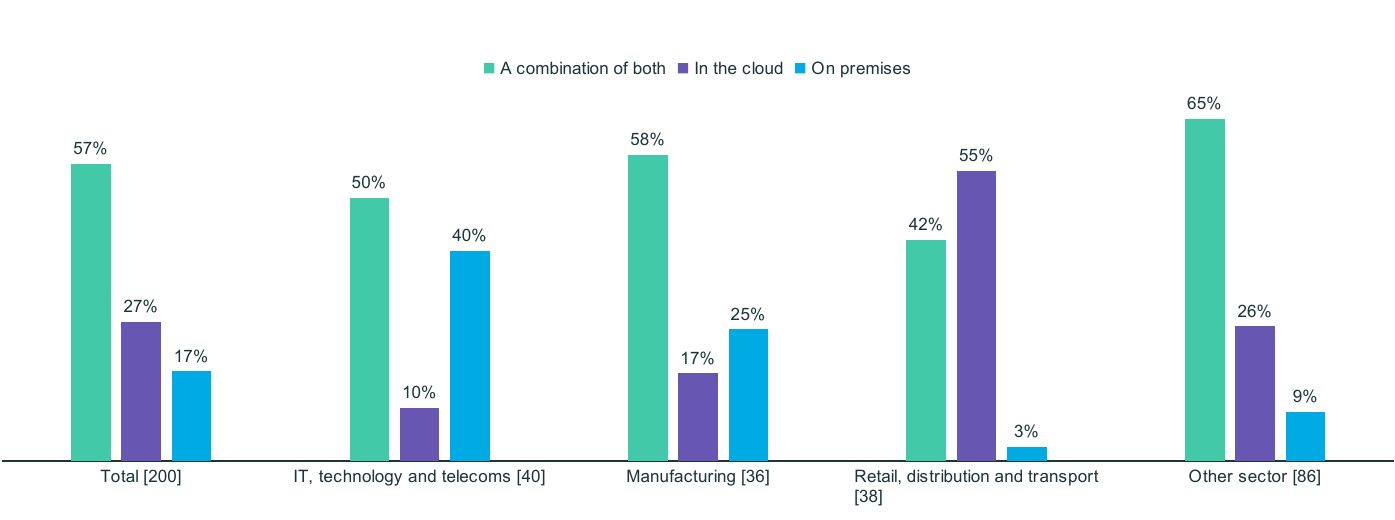Using public cloud infrastructure has gotten more expensive, and most IT departments are running hybrid cloud architectures, combining on-premises data centers with public clouds to meet their computing needs.
Those are some of the key findings from a recent survey of senior enterprise IT managers sponsored by Percona and titled "The Changing Face of Open Source." Almost 70 percent of respondents said cloud infrastructure got more expensive in the past year. That's probably because the pandemic drove up demand for cloud services, survey authors said.
Close to 60 percent of respondents said they were taking the hybrid approach. Of the rest, 27 percent are running their operations only in public clouds and 17 percent are relying solely on their on-prem infrastructure.
UK research firm Vanson Bourne surveyed 200 US-based IT decision makers in March and April, 50 of them representing medium-sized businesses with fewer than 1,000 employees, and 150 representing larger enterprises. Durham, North Carolina-based Percona, the study's sponsor, is an open source software company that supplies database products built around MySQL, MongoDB, and PostgreSQL.
"The transition to the cloud was accelerated by the worldwide pandemic and demand for flexible, fast, and reliable technology," the survey report read. "However, it’s likely the increase in demand led to an increase in costs -- 68% of respondents say that cloud infrastructure has become more expensive in the past year."
Of that 68 percent, only 8 percent found their cloud use to be "dramatically more expensive," with 60 percent ticking the "slightly more expensive" box.
Differences by Business Sector
Not surprisingly, the survey indicates that whether a company is using on-prem, cloud, or both is often dependent on what type of business it's in.
When breaking infrastructure use down by industry, 40 percent of "IT, technology and telecoms" say they don't use public clouds at all. But the rate of hybrid cloud adoption is high in this sector, with half of the companies surveyed relying on hybrid architectures, and the remaining 10 percent running everything in the cloud.
The manufacturing sector is most likely to be running hybrid infrastructures (68 percent), with 24 percent keeping all their compute on-prem, and 17 percent relying only on clouds.
"Retail, distribution and transport" is a category with the biggest portion of all-cloud infrastructure strategies, with 55 percent of respondents saying they do all their compute in public clouds, 42 percent taking a hybrid approach, and only 3 percent running their entire operations out of their own data centers.
In the catchall category of "other," 65 percent of the organizations are using hybrid cloud, 25 percent cloud only, and 9 percent are completely on-prem.

Open Source
The survey found that no matter where companies are doing their compute, they're using more open source software. Seventy-eight percent of the respondents said they've increased their use of open source software during the past 12 months, with 53 percent indicating a "slight increase," and 26 percent saying open source use was "significantly increased."
The perceived benefits of using open source varied depending on whether the response was coming from a board member or senior employee in the front office, or from someone in an IT supervisory role.
For example, of the 21 percent who saw avoiding lock-in as an important benefit, only 15 percent listed themselves as "board member or more senior," compared to 34 percent of the people who identified themselves as "departmental management or team/group supervisor."
Cost considerations on the other hand were more important to those working in IT than to the business higher-ups. Of the 50 percent who ticked the "cost saving" box, only 46 percent were front office suits while 59 percent were in the trenches.
Another oddity was that the front office also seems to care more about the company's reputation in the open source community. Of the 45 percent who saw that as a benefit, 48 percent were from upstairs, while only 26 percent worked in IT.
"This highlights that the importance of the open source community isn't lost on more senior team members," the survey authors noted.
The survey report is available here.





